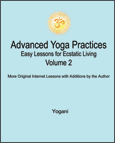|
Public Home | Plus Home | Main Lessons | Tantra Lessons | Public Forum | Plus Forum | Downloads | Books Topic Paths | Search | Training-Retreats | Testimonials | Survey | Interviews | MultiMedia | Contact | Donate |
|
Advanced Yoga Practices Note: For the Original Internet Lessons with additions, see the AYP Easy Lessons Books. For the Expanded and Interactive Internet Lessons, AYP Online Books, Audiobooks and more, see AYP Plus. Lesson 275 - Navi Kriya - The Middle Way (Audio)
AYP Plus Additions:
From: Yogani New Visitors: It is recommended you read from the beginning of the web archive, as previous lessons are prerequisite to this one. The first lesson is, "Why This Discussion?"
We have reached the stage in AYP where we will be filling in methods, practices and points of view on spiritual progress that we have said little about before now. These aspects of yoga were passed over either because they were not considered to be primary causes or data points in the overall process of human spiritual transformation, or are such powerful stimulators that it was felt they would best be presented later. Navi kriya is in the "powerful and best presented later" category. And now it is later, so let's take a look at navi kriya. Navi means "navel," as in the belly button. Interestingly, it also means, "boat," which is where we get the English word "navy." In yoga, both meanings are used: 1) A practice involving the navel, and 2) A boat that carries us over the great sea of ignorance to enlightenment. Well, we'd all like to be in that boat, and prudently applied yoga practices are the way to do it. Navi kriya is commonly believed to be a mental exercise, and this is where the funny phrase, "Contemplating your navel" comes from. Indeed, it can be and is done, and with mantras too. But that is not what we will be presenting here in AYP. We are already doing a first-rate mantra-based deep meditation practice, and will not be complicating (or watering down) that important aspect of our practice here. The navi kriya practice we will be discussing begins as mostly physical and gradually goes inward, and is in the same realm as our current mudras and bandhas, taking them all much higher -- literally. And this "taking higher" is where navi kriya provides a lot of extra power, and some extra risk. Let's talk about the practice first, and then look at the risk. An easy way to think of navi kriya is as a dynamic form of uddiyana, or the abdominal lift. You will recall that uddiyana is a pulling in and up of the belly, using the diaphragm to do it, usually when air is expelled from the lungs. It can also be done with lungs full in yoni mudra kumbhaka and chin pump. See lessons #91 and #129 for a review of uddiyana. Navi kriya is the process of making the abdominal lift dynamic between the navel and the area of the inner spine that is right behind the solar plexus (all the way back behind the hollow at the bottom/center of the ribs). The diaphragm is in this area too, so navi kriya can also be viewed as pulling the navel repeatedly up toward the back of the diaphragm in a gentle rhythmic cycle. Starting out, we can try this with breath expelled, as in uddiyana during asanas. Later on we will find we can do navi kriya either with air expelled, or when full with air in internal kumbhaka, or even when we are breathing normally. Whenever we do it, it is a gentle pulling in and up of the navel with the diaphragm, over and over. Good navi kriya will feel like it is all going right up behind our heart, and beyond. How many times do we do navi kriya in a session? Not many starting out. Navi kriya is a powerful kundalini stimulator, especially with features about to be mentioned, so go very easy with it starting out -- maybe 10-20 cycles, a second or two in duration each. There is more. With each inward lift of the navel in navi kriya, we can perform a gentle flex and lift of the anal sphincter -- this is mulabandha/asvini. With a little practice we will find that the movements in the abdominal area and the pelvic area are both parts of the same lifting process up through the middle. At the same time, we can add a gentle "flex" of sambhavi (with both the eyes and the center brow) with each lift of navi kriya. Kechari can be incorporated as well at whatever level we are doing. These also will be found to be neurologically part of the same movement we are initiating with the navel. This is assuming we have some ecstatic conductivity. Finally, with our attention, we can trace the energy up and down the spinal nerve between brow and root with each lift and release, much the way we do in spinal breathing. In fact, navi kriya can be done during spinal breathing in just this way, very subtly, invisibly, with the slightest intention, with multiple tiny lifts on the way up the spine and multiple tiny lifts on the way down the spine. This subtle intention of navi kriya is actually the rise of the whole body mudra we have discussed in previous lessons (#143 & #212). Navi kriya promotes the whole body mudra by working from the center. That is why it is called "the middle way." When is the best time to do navi kriya? It is a good question. It can be incorporated in our uddiyana practice during asanas. It can be built into our spinal breathing (much more subtly). It can be part of yoni mudra. It can be part of chin pump. It can be something we are doing at the end of our routine while we are lying down resting. Navi kriya is a way to promote the whole body mudra -- beginning as gross movement and later becoming an imperceptible body-wide micro-movement in our nervous system -- barely an intention in its advanced stages, like the neural energy flowing through us right now that we do not even notice. Yet, the flow of neural energy (prana) defines the experience of our existence, inner and outer. With the whole body mudra occurring spontaneously, our daily experience spontaneously becomes one of ecstatic radiance. This is the ecstatic component of the enlightenment profile mentioned often in these lessons - unshakable inner silence, ecstatic bliss and outpouring divine love. Now let's talk about the risks. The health risks in navi kriya are the same that we have reviewed in the lessons on yoni mudra kumbhaka (#91) and other practices involving breath retention and manipulating the internal organs. If you have blood pressure, heart or abdominal health issues, or any other doubts about your fitness for navi kriya, please consult a doctor. On the internal energy (kundalini) risk side -- If we jump in at the start doing navi kriya with gusto during uddiyana in asanas, spinal breathing, yoni mudra, chin pump and other parts of our practice, and if we have any ecstatic conductivity occurring, it will likely lead to an internal energy excess. Someone in the AYP forums recently used the phrase "getting a sunburn from the inside." That is what navi kriya will do if taken to excess. It can also lead to some emotional imbalance -- the whole kundalini excess thing, you know. So please be very careful with navi kriya. If you have a tendency toward energy imbalances, navi kriya will likely exaggerate it. On the other hand, those who are looking to expand on stable ecstatic conductivity will find navi kriya to be just the right thing. It is very important that you know where you are in your energy unfoldment as you consider undertaking navi kriya. If you are not sure, then please err on the side of less, not more. Maybe a little in uddiyana during asanas. See how that goes before you consider trying it in a longer practice like spinal breathing, or a more intense practice like yoni mudra kumbhaka or chin pump. There are also degrees of intensity of navi kriya practice itself -- very slight physical movement versus a lot of physical movement, with the latter being the greater stimulator. And, of course, the number of cycles will have a big effect on the outcome. Be measured in everything you do with navi kriya. That way you can make adjustments in practice as necessary. If you find yourself going over the line into excessive inner energy flows, then just stop using navi kriya completely for a few days at least. You may find you have to stop some of your other practices for a while as well to find a stable level of practice again. It is very important to understand the fine points of self-pacing when considering navi kriya. It is certain you will need good self-pacing, so be prepared. And it is also likely that you can greatly accelerate the positive rise of ecstatic conductivity in your nervous system with navi kriya as well, but only if you are ready and can handle it. It is a razor's edge. The stimulation of kundalini energy provided with navi kriya is similar to the stimulation occurring in crown practices -- only with a much quicker recovery time if there is an excess due to navi kriya. Recovery from a premature crown opening can take a lot longer -- years! You know how we have addressed crown practices in AYP -- avoid them until very far down the road, and then test carefully (lesson #199). It is similar with navi kriya, only with not quite as much risk as when approaching the crown. Make sure you are well-established with all the practices we have discussed thus far before you consider navi kriya. Then test carefully to find out if this powerful procedure can be gradually blended into your practice. If you are ready and can do that, in time you will find the subtle whole body movement occurring in daily activity as a natural ecstatic response, without any inner energy imbalances -- just unending inner ecstasy. And if you are not ready yet, you will find out soon enough. Then just leave it alone until later. It will be here when you need it. If one is a beginner in yoga and tries navi kriya, not much may happen. Don't be fooled by this and start going at it with reckless abandon. Using navi kriya to try and "break through" energy blockages is a good way to get into trouble. As soon as there is some ecstatic conductivity in the nervous system, navi kriya will expand it with great power. Before ecstatic conductivity comes up, not much may seem to happen with navi kriya. It will be like sitting in a fast racing car with no fuel in it. As soon as there is some fuel (some ecstatic conductivity rising in the nervous system) the car will be ready to blast off. If we have our foot pressing the gas pedal to the floor when this happens, a spatula will be needed to scrape us up off the pavement. Let's be sure and know what we are doing when we undertake navi kriya. The best way is to be established in deep meditation, spinal breathing, samyama, mudras and bandhas, etc. Everything we have covered up until now. By the time we build up with all that, we will have some good inner silence and, likely, the beginnings of ecstatic conductivity -- very safe and very stable. Then we can start off very slow with some navi kriya... like that. It is up to the practitioner. Navi kriya requires much more skill to apply successfully than most of the AYP practices. It does not lend itself easily to a "cookbook" approach. That is one reason why it has been held off until now. Yet, it can be very useful. So now you have it. One might ask, "What is the relationship between navi kriya and nauli?" Nauli (which means "to churn") is a close cousin of uddiyana and navi kriya. The difference is that nauli is geared more toward purification and ecstatic activation of processes in the GI tract, an important element in the overall rise of the spiritual neuro-biology throughout the body. Nauli is part of the "shatkarmas," or cleansing techniques. We will be discussing those in a later lesson. Uddiyana and navi kriya are more vertical in the body, affecting the spinal nerve in particular, lifting from root to third eye. Uddiyana means, "to fly up." Navi kriya is about flying up much more, and integrating upper and lower body mudras and bandhas into a single whole body mudra. The results of this upward flying inner energy will be felt in every aspect of our practice and daily life. Practice wisely, and enjoy! The guru is in you.
Discuss this Lesson in the AYP Plus Support Forum
Note:
For instructions on
mudras and bandhas, see the Asanas,
Mudras and Bandas book.
For
instructions on
shatkarmas, see the
Diet, Shatkarmas and Amaroli
book.
Also see AYP Plus. |
|
|
|
Join the Mail List:
AYP Retreats
eBooks - PDF, EPUB
FREE eBooks with
SAVE with Bundled
|

























